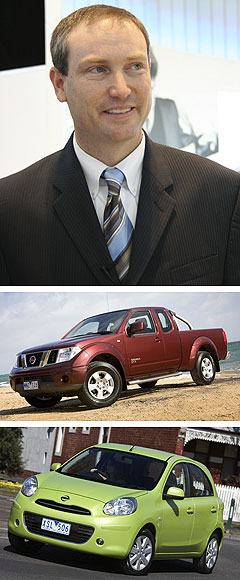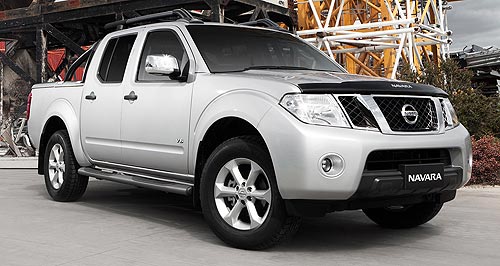Future models - Nissan - NavaraNissan scours world for more NavarasSupplementary sources: Nissan Australia managing director and CEO Dan Thompson says his company should be selling 500 D22 Navaras a months, but are being hampered by supply. Shortage of Navara stock prompts Nissan Australia to seek three-pronged supply8 Aug 2011 A RESUMPTION of shipments of Japanese-made Navara utes is on the agenda at Nissan Australia to supplement supplies from current sources in Spain and Thailand by between 500 and 1000 units a month to meet showroom demand. If successful, the three-pronged supply move could threaten Toyota HiLux’s leadership in one of Australia’s biggest market segments while also boosting Nissan’s chances of achieving its ambitious goals of 10 per cent overall market share and number-one full-import brand by March 2013. Nissan is also looking to factories beyond Thailand for extra supplies of its Micra, with India and Indonesia possible sources of the light car that, along with Navara, X-Trail and Dualis, is regarded by Nissan Australia as one of its four core models. Nissan Australia managing director and CEO Dan Thompson told GoAuto that Navara supply out of Thailand had been constrained this year due to the success of the vehicle across Asia, the Middle East and Australia, where collective demand had grown dramatically. Most Navara production for Australia had been centralised in Thailand, including the D22 workhorse and some of the flagship D40 ST-X production previously in Spain. At the time, the Thai factory could handle the demand, but now supply to Australia was constricted.  Left: Nissan Australia managing director and CEO Dan Thompson. Below: Nissan Navara King Cab and Micra. Left: Nissan Australia managing director and CEO Dan Thompson. Below: Nissan Navara King Cab and Micra.Mr Thompson said his company should be selling 500 D22 Navaras a month, but had been left with only 250 on the ground at the end of July. To solve the issue, he said Nissan Australia had been working on alternative sourcing for the past six to 12 months. “We’ve been studying going back to Japan, going back to Spain, to supplement Thailand,” he said. “We won’t pull the whole thing out of Thailand, but we could be selling another 500 to 1000 Navaras (a month) if we had supply.” Mr Thompson said extra shipments could add between 4000 and 5000 sales a year to the Navara tally. Last year, Nissan sold 21,171 Navaras, compared with Toyota’s tally of 39,896 for HiLux. This year, Navara sales are running more than eight per cent ahead of last year’s pace, putting it on target to top 24,000 units. HiLux has a huge lead in 4x2 ute sales this year – 7558 to Navara’s 1122 year to date – but the Navara is a lot closer in 4x4 volumes, with 12,476 sales to HiLux’s 14,117. However, supplies of the HiLux out of Thailand have been cut by production delays caused by the Japanese earthquake in March this year. The Toyota ute also is about to get a facelift, with a new nose and tail and upgraded safety and features from September. As GoAuto reported last month, the Navara is also set to be reworked in early 2012, when production of the one-tonner is scheduled to be shifted from Nissan’s Thai plant to Mitsubishi’s factory in Thailand, where it will be built alongside the Triton. Eventually, the Navara and Triton will be built on a common platform, in the same way as Ford’s Ranger and its twin, the Mazda BT-50. Mr Thompson said the factory shift would increase production, but not entirely solve Navara stock shortages. He said Nissan Australia had resumed shipping D40 ST-X and V6 supplies from Spain, thanks to a more favourable exchange rate with the Euro that previously had been “killing us”. “You’ll never solve the logistics of the time side of it (shipping cars from Spain to Australia) but as far as the cost base – when you take into account currency – sourcing product out of Europe has become much more feasible, or profitable,” he said. “So we’ve gone back to Spain.” Mr Thompson said the question is whether the Spanish factory can increase supply to Australia, prompting Nissan Australia to talk with its head office about obtaining some supplies from Japan. He said Nissan would expand production generally around the world under its Nissan Power 88 plan, under which it was aiming for eight per cent global market share by 2016. New plants had been opened in India and Brazil, production was being expanded in Indonesia and billions of dollars was being spent in China to increase capacity. Mr Thompson said this opened up sourcing opportunities for Nissan Australia, including for the Micra light car that is currently supplied out of Thailand. “That gives me a lot of comfort, that we’re not solely centred on Japan or Thailand,” Mr Thompson said. “A lot of our competitors here are really reliant on (certain production centres), whether it’s Korea or Japan or Thailand. “So now, not only are we going from four sites, but there is potential to source out of Indonesia, out of India, and the potential to source out of the US. “And this is all in the next three to five years, which gives us a lot of flexibility – a lot of complexity, which is a challenge, but also a lot of flexibility.” Mr Thompson said China was not on the import agenda for Nissan Australia “in the short-term or not even in the medium-term”, but he confirmed India and Indonesia were prospects for Micra. India already makes Micra for Europe alongside domestic supplies of the car for India, where it is called March. He said Indonesia originally had not been earmarked for Micra/March production, but the success of the car across Asia prompted Nissan to establish a ‘CKD’ (completely knocked down) assembly operation in Indonesia using parts shipped from Thailand. Last month, Nissan sold a record 1184 Micras in Australia – up more than 80 per cent on July last year. This not only made it the second-best-selling light car in Australia for the month, trailing only the Mazda2, but also Nissan’s second-best-selling model, behind the Navara. Mr Thomson said Nissan Australia had weathered the storm of the Japanese earthquake disaster, helped by the fact that only one of its core models, the X-Trail, was made in Japan. He said Nissan had “just ploughed through” this year, raising its Australian market share from 6.1 per cent this time last year to 6.8 per cent at the end of July.  Read more25th of July 2011  Nissan recalls D40 NavarasPotentially cracked alloy wheels bring more than 29,000 Nissan Navaras back in OzAll future models Alfa Romeo Alfa Romeo Abarth Abarth Audi Audi Aston Martin Aston Martin BMW BMW Bentley Bentley Chrysler Chrysler Chevrolet Chevrolet Dodge Dodge Citroen Citroen Ferrari Ferrari DS DS Ford Ford Fiat Fiat FPV FPV Foton Foton Haval Haval Great Wall Great Wall Honda Honda Holden Holden Hyundai Hyundai HSV HSV Isuzu Isuzu Infiniti Infiniti Jeep Jeep Jaguar Jaguar Lamborghini Lamborghini Kia Kia Lexus Lexus Land Rover Land Rover Mazda Mazda Maserati Maserati Mercedes-Benz Mercedes-Benz McLaren McLaren Mini Mini Nissan Nissan Mitsubishi Mitsubishi Peugeot Peugeot Opel Opel Proton Proton Porsche Porsche Renault Renault Ram Ram Saab Saab Rolls-Royce Rolls-Royce Smart Smart Skoda Skoda Subaru Subaru SsangYong SsangYong Tesla Tesla Suzuki Suzuki Toyota Toyota Volvo VolvoNavara pricing
Motor industry news |
Click to shareNissan modelsResearch Nissan All future models Alfa Romeo Alfa Romeo Abarth Abarth Audi Audi Aston Martin Aston Martin BMW BMW Bentley Bentley Chrysler Chrysler Chevrolet Chevrolet Dodge Dodge Citroen Citroen Ferrari Ferrari DS DS Ford Ford Fiat Fiat FPV FPV Foton Foton Haval Haval Great Wall Great Wall Honda Honda Holden Holden Hyundai Hyundai HSV HSV Isuzu Isuzu Infiniti Infiniti Jeep Jeep Jaguar Jaguar Lamborghini Lamborghini Kia Kia Lexus Lexus Land Rover Land Rover Mazda Mazda Maserati Maserati Mercedes-Benz Mercedes-Benz McLaren McLaren Mini Mini Nissan Nissan Mitsubishi Mitsubishi Peugeot Peugeot Opel Opel Proton Proton Porsche Porsche Renault Renault Ram Ram Saab Saab Rolls-Royce Rolls-Royce Smart Smart Skoda Skoda Subaru Subaru SsangYong SsangYong Tesla Tesla Suzuki Suzuki Toyota Toyota Volvo VolvoNavara pricing
Motor industry news |
















Facebook Twitter Instagram